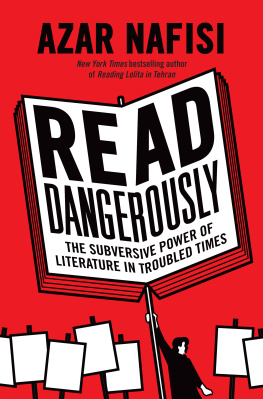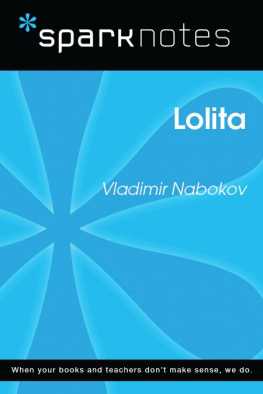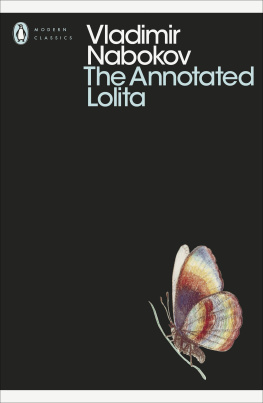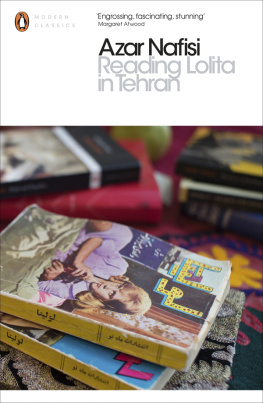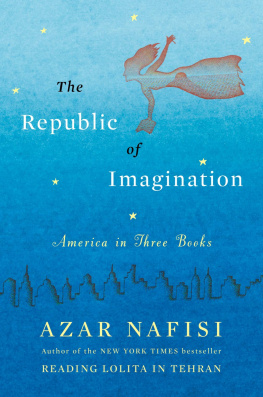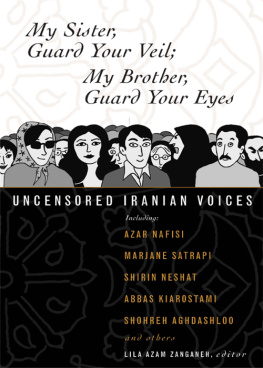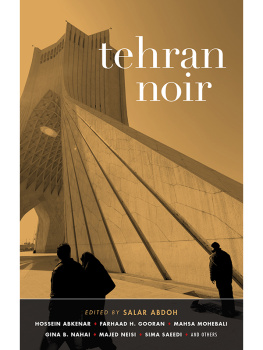Azar Nafisi - Reading Lolita in Tehran: A Memoir in Books
Here you can read online Azar Nafisi - Reading Lolita in Tehran: A Memoir in Books full text of the book (entire story) in english for free. Download pdf and epub, get meaning, cover and reviews about this ebook. year: 2003, publisher: Random House, genre: Art. Description of the work, (preface) as well as reviews are available. Best literature library LitArk.com created for fans of good reading and offers a wide selection of genres:
Romance novel
Science fiction
Adventure
Detective
Science
History
Home and family
Prose
Art
Politics
Computer
Non-fiction
Religion
Business
Children
Humor
Choose a favorite category and find really read worthwhile books. Enjoy immersion in the world of imagination, feel the emotions of the characters or learn something new for yourself, make an fascinating discovery.

- Book:Reading Lolita in Tehran: A Memoir in Books
- Author:
- Publisher:Random House
- Genre:
- Year:2003
- Rating:5 / 5
- Favourites:Add to favourites
- Your mark:
- 100
- 1
- 2
- 3
- 4
- 5
Reading Lolita in Tehran: A Memoir in Books: summary, description and annotation
We offer to read an annotation, description, summary or preface (depends on what the author of the book "Reading Lolita in Tehran: A Memoir in Books" wrote himself). If you haven't found the necessary information about the book — write in the comments, we will try to find it.
Azar Nafisi: author's other books
Who wrote Reading Lolita in Tehran: A Memoir in Books? Find out the surname, the name of the author of the book and a list of all author's works by series.
Reading Lolita in Tehran: A Memoir in Books — read online for free the complete book (whole text) full work
Below is the text of the book, divided by pages. System saving the place of the last page read, allows you to conveniently read the book "Reading Lolita in Tehran: A Memoir in Books" online for free, without having to search again every time where you left off. Put a bookmark, and you can go to the page where you finished reading at any time.
Font size:
Interval:
Bookmark:
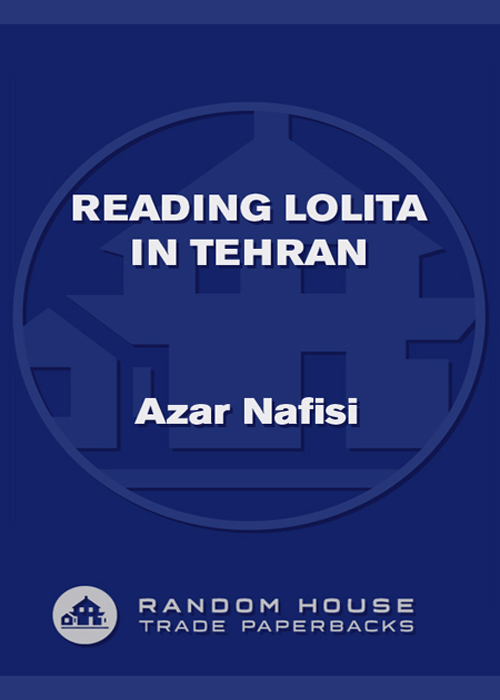
Reading
Lolita
in
Tehran
a memoir in books
Azar Nafisi

RANDOM HOUSE
TRADE PAPERBACKS
NEW YORK
CONTENTS
IN MEMORY OF MY MOTHER, NEZHAT NAFISI
FOR MY FATHER, AHMAD NAFISI,
AND MY FAMILY: BIJAN, NEGAR AND DARA NADERI
To whom do we tell what happened on the
Earth, for whom do we place everywhere huge
Mirrors in the hope that they will be filled up
And will stay so?
Czeslaw Milosz, Annalena
AUTHORS NOTE
Aspects of characters and events in this story have been changed mainly to protect individuals, not just from the eye of the censor but also from those who read such narratives to discover whos who and who did what to whom, thriving on and filling their own emptiness through others secrets. The facts in this story are true insofar as any memory is ever truthful, but I have made every effort to protect friends and students, baptizing them with new names and disguising them perhaps even from themselves, changing and interchanging facets of their lives so that their secrets are safe.
PART I
Lolita
In the fall of 1995, after resigning from my last academic post, I decided to indulge myself and fulfill a dream. I chose seven of my best and most committed students and invited them to come to my home every Thursday morning to discuss literature. They were all womento teach a mixed class in the privacy of my home was too risky, even if we were discussing harmless works of fiction. One persistent male student, although barred from our class, insisted on his rights. So he, Nima, read the assigned material, and on special days he would come to my house to talk about the books we were reading.
I often teasingly reminded my students of Muriel Sparks The Prime of Miss Jean Brodie and asked, Which one of you will finally betray me? For I am a pessimist by nature and I was sure at least one would turn against me. Nassrin once responded mischievously, You yourself told us that in the final analysis we are our own betrayers, playing Judas to our own Christ. Manna pointed out that I was no Miss Brodie, and they, well, they were what they were. She reminded me of a warning I was fond of repeating: do not, under any circumstances, belittle a work of fiction by trying to turn it into a carbon copy of real life; what we search for in fiction is not so much reality but the epiphany of truth. Yet I suppose that if I were to go against my own recommendation and choose a work of fiction that would most resonate with our lives in the Islamic Republic of Iran, it would not be The Prime of Miss Jean Brodie or even 1984 but perhaps Nabokovs Invitation to a Beheading or better yet, Lolita.
A couple of years after we had begun our Thursday-morning seminars, on the last night I was in Tehran, a few friends and students came to say good-bye and to help me pack. When we had deprived the house of all its items, when the objects had vanished and the colors had faded into eight gray suitcases, like errant genies evaporating into their bottles, my students and I stood against the bare white wall of the dining room and took two photographs.
I have the two photographs in front of me now. In the first there are seven women, standing against a white wall. They are, according to the law of the land, dressed in black robes and head scarves, covered except for the oval of their faces and their hands. In the second photograph the same group, in the same position, stands against the same wall. Only they have taken off their coverings. Splashes of color separate one from the next. Each has become distinct through the color and style of her clothes, the color and the length of her hair; not even the two who are still wearing their head scarves look the same.
The one to the far right in the second photograph is our poet, Manna, in a white T-shirt and jeans. She made poetry out of things most people cast aside. The photograph does not reflect the peculiar opacity of Mannas dark eyes, a testament to her withdrawn and private nature.
Next to Manna is Mahshid, whose long black scarf clashes with her delicate features and retreating smile. Mahshid was good at many things, but she had a certain daintiness about her and we took to calling her my lady. Nassrin used to say that more than defining Mahshid, we had managed to add another dimension to the word lady. Mahshid is very sensitive. Shes like porcelain, Yassi once told me, easy to crack. Thats why she appears fragile to those who dont know her too well; but woe to whoever offends her. As for me, Yassi continued good-naturedly, Im like good old plastic; I wont crack no matter what you do with me.
Yassi was the youngest in our group. She is the one in yellow, bending forward and bursting with laughter. We used to teasingly call her our comedian. Yassi was shy by nature, but certain things excited her and made her lose her inhibitions. She had a tone of voice that gently mocked and questioned not just others but herself as well.
I am the one in brown, standing next to Yassi, with one arm around her shoulders. Directly behind me stands Azin, my tallest student, with her long blond hair and a pink T-shirt. She is laughing like the rest of us. Azins smiles never looked like smiles; they appeared more like preludes to an irrepressible and nervous hilarity. She beamed in that peculiar fashion even when she was describing her latest trouble with her husband. Always outrageous and outspoken, Azin relished the shock value of her actions and comments, and often clashed with Mahshid and Manna. We nicknamed her the wild one.
On my other side is Mitra, who was perhaps the calmest among us. Like the pastel colors of her paintings, she seemed to recede and fade into a paler register. Her beauty was saved from predictability by a pair of miraculous dimples, which she could and did use to manipulate many an unsuspecting victim into bending to her will.
Sanaz, who, pressured by family and society, vacillated between her desire for independence and her need for approval, is holding on to Mitras arm. We are all laughing. And Nima, Mannas husband and my one true literary criticif only he had had the perseverance to finish the brilliant essays he started to writeis our invisible partner, the photographer.
There was one more: Nassrin. She is not in the photographsshe didnt make it to the end. Yet my tale would be incomplete without those who could not or did not remain with us. Their absences persist, like an acute pain that seems to have no physical source. This is Tehran for me: its absences were more real than its presences.
When I see Nassrin in my minds eye, shes slightly out of focus, blurred, somehow distant. Ive combed through the photographs my students took with me over the years and Nassrin is in many of them, but always hidden behind somethinga person, a tree. In one, I am standing with eight of my students in the small garden facing our faculty building, the scene of so many farewell photographs over the years. In the background stands a sheltering willow tree. We are laughing, and in one corner, from behind the tallest student, Nassrin peers out, like an imp intruding roguishly on a scene it was not invited to. In another I can barely make out her face in the small V space behind two other girls shoulders. In this one she looks absentminded; she is frowning, as if unaware that she is being photographed.
How can I describe Nassrin? I once called her the Cheshire cat, appearing and disappearing at unexpected turns in my academic life. The truth is I cant describe her: she was her own definition. One can only say that Nassrin was Nassrin.
Next pageFont size:
Interval:
Bookmark:
Similar books «Reading Lolita in Tehran: A Memoir in Books»
Look at similar books to Reading Lolita in Tehran: A Memoir in Books. We have selected literature similar in name and meaning in the hope of providing readers with more options to find new, interesting, not yet read works.
Discussion, reviews of the book Reading Lolita in Tehran: A Memoir in Books and just readers' own opinions. Leave your comments, write what you think about the work, its meaning or the main characters. Specify what exactly you liked and what you didn't like, and why you think so.

